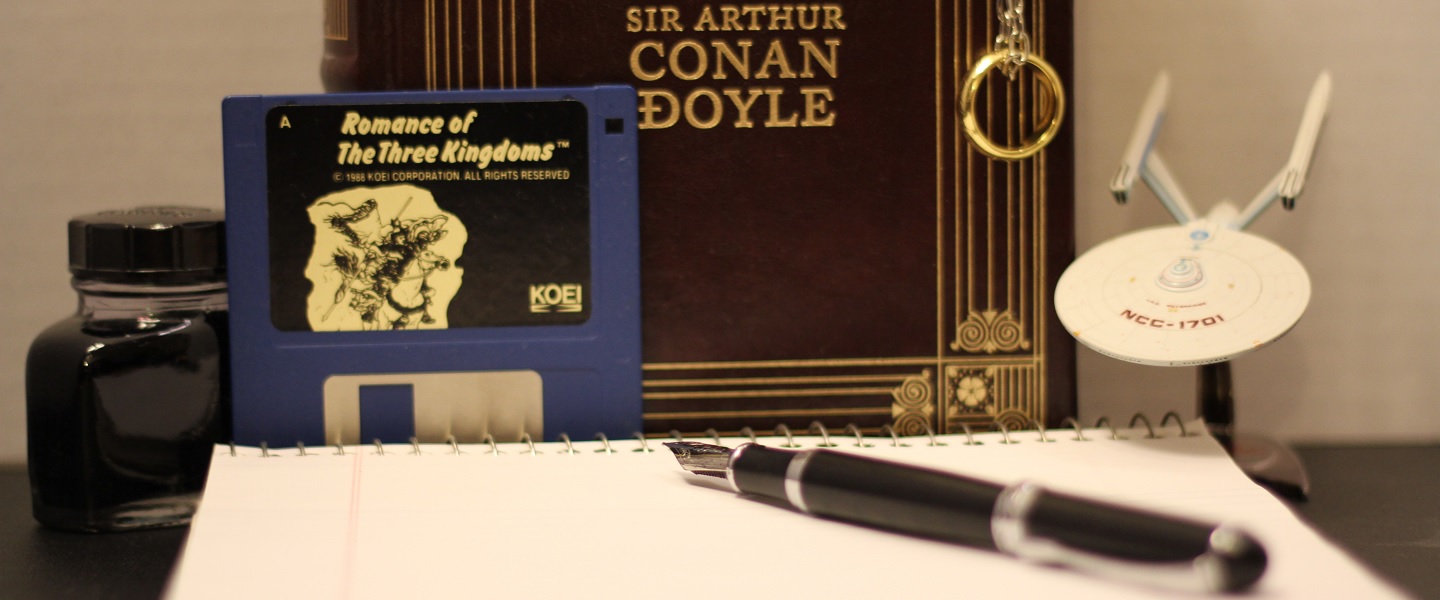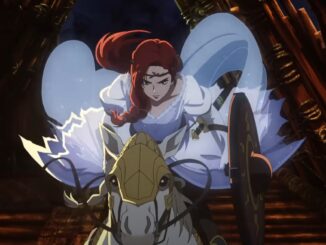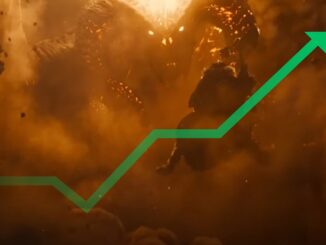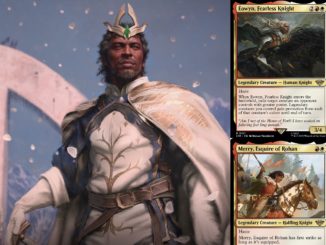
It should be a great time for fans of J.R.R. Tolkien and Middle-earth. Since the overwhelming success of Peter Jackson’s The Lord of the Rings trilogy, fans were ready to see other stories brought to the screen both large and small. The hope was that, while everyone wanted to hop aboard the Tolkien gravy train, these creators would still be cognizant and respectful to the source with their adaptations. Unfortunately, that hasn’t been the case as Tolkien fans witnessed with Amazon’s The Lord of the Rings: The Rings of Power. In fact, respect to the source material has never been shown by works released since Jackson’s trilogy and, regarding one of the more recent adaptations, red flags are showing up for The Lord of the Rings: The War of the Rohirrim.
When The Lord of the Rings: The War of the Rohirrim was first announced, the details revealed about the animated film gave the impression that Helm Hammerhand would be the main protagonist. In fact, if you read the early articles covering the then-announced film, that was the plot, according to Variety, which reported on The War of the Rohirrim back in 2022,
“Set roughly two centuries before the events of J.R.R. Tolkien’s ‘The Hobbit’ and ‘The Lord of the Rings,’ ‘The War of the Rohirrim’ will explore the exploits of Helm Hammerhand, the King of Rohan, and the creation of Helm’s Deep, the stronghold featured in Peter Jackson‘s ‘The Lord of the Rings: The Two Towers.’”
However, that was no longer to be the case as it was revealed that the focus of the main protagonist has shifted from Helm Hammerhand to his daughter according to Variety,
“The new story is set nearly 200 years before Bilbo Baggins comes into contact with the ring of power, and centers on the House of Helm Hammerhand, the King of Rohan (voiced by Brian Cox), with a focus on his daughter, the strong willed Princess Héra (voiced by Gaia Wise). In the clip, a dispute erupts during a council meeting, leaving Wulf, a ruthless Dunlending lord, seeking vengeance. Miranda Otto reprises her “Lord of the Rings” role as Éowyn, this time as the movie’s narrator.”
Who is Héra in The Lord of the Rings: The War of the Rohirrim?
According to J.R.R. Tolkien, she is the unnamed daughter of Helm Hammerhand. Helm Hammerhand, whose story was told within two pages of the Appendices from The Lord of the Rings: The Return of the King. But those two pages in “Appendix A Section II: The House of Eorl” told a very intriguing story about Hammerhand who refused to marry off his unnamed daughter to a man named Wulf, which was proposed by his father Freca, and the war which broke out between Rohan and the Dunlendings after Helm hit Freca who died shortly after from the blow.
It was a story about a proud ruler and father being driven to despair and rage as his two sons are killed, Edoras taken, his people decimated and the survivors slowly succumbing to the long winter and starvation. It’s about a man who, suffering from grief and the results of his actions, harnesses his pain and rage which results in him going out into the cold and slaughtering his enemies by himself with his bare hands – sounding his horn as a warning and to strike fear in them.
Yet, somehow, the unnamed daughter is going to take center stage of this story. Don’t get me wrong. It makes sense to flesh out his daughter since she is one of the main reasons for war with the Dunlendings. In fact, there are many things that could be done to make her more interesting. For example, maybe she was willing to marry in order to save her people from going to war, leading to an argument with Helm about the situation.
A highly unlikely scenario, but a possible one.
But the shift from Helm to Héra is a major red flag.

The shift of the film’s focus makes no sense. Until one looks at the fact that the original script from the initial writers, Jeffrey Addiss and Will Matthews, has been changed by Phoebe Gittins and writing partner Arty Papageorgiou who are penning the screenplay.
What is interesting here is that both pairs of writers have very little experience. However, Addiss and Matthews’s work, The Dark Crystal: Age of Resistance, won awards and nominations such as a 2021 Saturn Award nominee for Best Fantasy Television series, a 2020 Critics Choice Award nominee for Best Animated Series, and the 2020 Primetime Emmy winner for Outstanding Children’s Program (94% audience score on Rotten Tomatoes). Gittins and Papageorgiou, on the other hand, wrote a drama movie titled The Sorrows which hasn’t even received any ratings on Rotten Tomatoes or IMDB.
It should not be surprising to say that this is usually not a good sign when writers are switched during a project. But while there are a number of films which benefited from a rewrite, there are still many others which suffered greatly because of the change in writers and the script. It also tends to be a bad indicator when the story’s direction is changed as well.
With this switch of the main protagonist, Tolkien fans have a right to be worried. Especially when the films original runtime was supposed to be 90 minutes and has been increased to 2 hours and 10 minutes. An indication that there could be a lot of bloat to the story that has already undergone a massive change in direction.
Another red flag.
What compounds the issue with the switching of writers is the fact that Phoebe Gittins is Philippa Boyens’s daughter. While a certain degree of nepotism in movies is not unexpected, such as Peter Jackson’s children making appearances in the Lord of the Rings/Hobbit movies or Ryan Reynolds casting his wife and daughter for minor roles in Deadpool & Wolverine, it tends to become a problem when it is for more prominent roles and positions.
One can look to Indiana Jones and the Temple of Doom in which Steven Spielberg’s then-girlfriend Kate Capshaw was cast in the role of Willie Scott; a character that many fans agree was a low point for the movie. Or, a more recent example, The Acolyte’s creator Leslye Headland, former assistant to Harvey Weinstein, casting her wife as Jedi Master Vernestra Rwoh for a show that has been labeled as the worst Disney property to date and was recently canceled.
So the fact that Phoebe Gittins was put in a prominent role to write the animated film without any real credited experience, is a disconcerting red flag. Even with her mother having worked on The Lord of the Rings movies, this doesn’t bode well.
With Philippa Boyens and her daughter Phoebe Gittins in charge of the project, the switch in The War of the Rohirrim’s direction makes more sense. Especially in light of an interview with Boyens where she talked about Helm Hammerhand’s unnamed daughter,
“In the appendices where the story is drawn from, we get these quite interestingly drawn male characters, and then we get this young female character who is never named — and that was really interesting to me. We know Helm has a daughter, and we know that she was central to the conflict that happened. But myself, and especially screenwriter Phoebe Gittins, were drawn to her. We could feel the weight of being that unnamed daughter, which immediately piqued our interest: Who was she? How did she live?”
What is odd about Boyens’s statement is not that she and her daughter were drawn to Helm’s unnamed daughter. Rather, it is the extent of how obsessive they are over a character that J.R.R. Tolkien didn’t even bother to name or give any real agency to outside of the daughter being A reason for the war but not THE reason. An example, one could posit, of how older women see themselves as younger women, which would explain why there is so much emphasis put on this daughter which they decided to name Héra. A name that Boyens acknowledges doesn’t fit Tolkien’s naming convention for the Rohirrim.
While the information surrounding Héra is being kept close to the chest, what little that has been said certainly is cause for concern. During an interview with Nerd of the Rings, Phoebe Gittins spoke about how they saw Héra saying, “…it’s about her choice and having the ability to choose…”
What is disconcerting about Gittins’s statement is that it echoes the “girl boss” mentality and many modern women. For the case of Héra, an argument could be made that it is no longer the issue of duty to family and duty to country, but what is best for her. A mentality we have seen played out ad nauseam in Hollywood; more specifically when it comes to action and superhero movies and shows – Captain Marvel, She-Hulk: Attorney at Law, The Marvels, Ghostbusters (2016), Charlie’s Angels (2019), The Acolyte, and more.
So this appears to be the case as a little more information has been revealed about Héra in an article from The Wrap talking about how Héra can “commune with the Great Eagles,” will be leading the people, and “calling on the power of a seemingly long-lost tribe of female warriors.”
Appears there is at least another woman fighting in The Lord of the Rings: The War of the Rohirrim.
I wonder who she is?
Any guesses?#WaroftheRohirrim #RespectforTolkien #Rohirrim #Tolkien #LOTR #LordoftheRings pic.twitter.com/HlxyR8JNJS
— Sean D Knight (@SeanDKnight) November 15, 2024
What this “long-lost tribe of female warriors” could be is up for speculation. Whether it is a bunch of women of Rohan who broke off to form their own tribe or perhaps a tribe of Easterlings, who knows? But most likely this could be a tribe of surviving Wainriders since it is mentioned in The Unfinished Tales under “Cirion And Eorl And The Friendship Of Gondor And Rohan” which states,
“But most of them had perished in the attempt; for they were ill-armed, and the enemy had not left their homes undefended: their youths and old men were aided by the younger women, who in that people were also trained in arms and fought fiercely in defence of their homes and their children.”
Even then, it is hard to believe that a lost-tribe of Wainriders would even want to help Rohan.
But that’s not even addressing the gigantic oliphaunt in the room: Tolkien wrote this story that doesn’t mention women having a prominent role in this war. Specifically, not when it comes to fighting.

For all intents and purposes, it sounds as if the story of Helm Hammerhand is being subverted in order to prop up a female character. In fact, it runs parallel to a modern-day Disney princess super warrior-in-the-making. Which is to not say that Héra shouldn’t wield a weapon. My worry is that they will make her exceptional in many things to the detriment of the male characters like we have seen in movies such as Prey where the male characters are made to look dumb and stupid to a ludicrous and illogical degree in order to make the female character be smarter.
But with Héra being the main focus, the worry is that this heavily takes away from the main characters which is Helm, his two sons, and Fréaláf. Boyens and company had a great story to flesh out which should have focused on a father and his sons who paid the ultimate price for their father’s actions and the grief of the father watching his sons die and the kingdom lost because of his decisions and his failure to protect the realm. Not to mention the buildup of Fréaláf, to bring in at the finale, where he retakes Edoras and eventually becomes the next king of Rohan.
Will this happen in the movie? It should be expected. But now that story is undermined by a character that is being self-inserted to have more of an impact than would be expected of her. Héra’s involvement in the story would have made more sense as someone holding the people together whenever her father would venture out into the cold to slay the enemy. Or arguing with her father about how to keep their people alive. Maybe staying in communication with Fréaláf and, upon sending news of Helm’s death, spurs him to attack. There are many ways to give Héra more agency without detracting from the main story and focus.
However, what Boyens and company are doing with Héra is not surprising. One only has to look at The Lord of the Rings and The Hobbit movies to see that this is something that Boyens wanted to do though, to be fair, it can’t be solely attributed to her. After all, this was supposed to be how Arwen was going to be portrayed in the LOTR trilogy and was slightly portrayed as. From replacing Glorfindel so that Arwen could wield a sword and be responsible for summoning the waves to wash away the Ringwraiths to her deleted scenes of fighting at Helm’s Deep which, one could postulate, is why the Elves’ non-canonical presence at Helm’s Deep was included in order to make her more than what she was in the books. It is why, one can assume, the character of Tauriel was created for The Hobbit movies, because Peter Jackson, Fran Walsh, and Philippa Boyens wanted a strong, female role which they ruined with a pathetic love-triangle story. In essence, Tauriel was Arwen 2.0.
Arwen and Tauriel were early examples of the girl boss mentality making its way into Tolkien’s world. After all, Arwen’s portrayal in the movies is nothing like what Tolkien fans would have expected for the granddaughter of Galadriel: that she was more like Luthien and Melian rather than a warrior-type. At least Tauriel would have been a more accepted character if there had been no romance story for her.
What is disappointing about The War of the Rohirrim’s focus on Héra is that, if this is what Boyens wanted all along, then there are a number of stories, which Tolkien wrote, that could have been used for a girl boss story that wouldn’t have to sacrifice male characters. Characters such as Lady Haleth, Emeldir, Princess Idril, and a few others who had some awesome tales.
The red flags for Warner Bros The Lord of the Rings: The War of the Rohirrim may not be many, but they are highly detrimental to the story of Helm Hammerhand. A shift in focus that also follows in the path of Amazon’s The Lord of the Rings: The Rings of Power’s overwhelming girl boss mentality. Which doesn’t make sense since Tolkien wrote brilliant female characters that are waiting to have their stories brought to the screen without being subverted or at the expense of undermining the male characters.
One can respect Philippa Boyens for her talent and role in The Lord of the Rings and The Hobbit movies. But that doesn’t mean that the signs should be ignored for what is happening with The War of the Rohirrim. The direction it has taken is not a promising one.
However, there is one last red flag and that is the use of memberberries. Only recently have Peter Jackson and Fran Walsh been associated with The War of the Rohirrim who, up until now, were never mentioned and have not worked on the film. But as we are seeing in regards to The Lord of the Rings: The Hunt for Gollum, Jackson’s name is being used to draw interest for these projects. In addition, Miranda Otto being the narrator is another lure and the fact this movie is relying on memberberries to sell it could be seen as a bad sign. But it is, to be fair, a weak one unless the movie starts to rely on even more such tactics to keep promoting it (Update: It has.
But we will have to wait for the first trailer and more information to see how all of this unfolds.
Are you going to see The Lord of the Rings: The War of the Rohirrim in theaters, boycott it, or wait for it on streaming platforms/DVDs?
Note: This editorial was written before the release of the first trailer.
Follow-up: Why The Lord of the Rings: The War of the Rohirrim Trailer Fails With Tolkien Fans And General Audiences
Why an 8-Minute Clip from The Lord of the Rings: The War of the Rohirrim Hurts More Than Helps
Tolkien’s Corner: The Lord of the Rings Brand is Poisoned and Corrupted
Author’s Note: Support this site by donating via Paypal or even checking out our merchandise on RedBubble where you can find designs that cater to writers and readers. Money donated and raised goes into paying for this website and equipment.
Check out our Non-BUYnary txt design!






[…] [ August 22, 2024 ] Subversion, Nepotism, and Girl Boss Mentality – The Red Flags For The … […]
[…] [ August 22, 2024 ] Subversion, Nepotism, and Girl Boss Mentality – The Red Flags For The … […]
[…] additional The Lord of the Rings movies on the horizon that includes The War of the Rohirrim and The Hunt for Gollum, it is a surprise to see any company divest itself of a Lord of the Rings […]
[…] it comes to The War of the Rohirrim, the anime film is already hampered by a number of red flags which includes subversion of Tolkien’s story about Helm Hammerhand, nepotism, heavy reliance on […]
[…] the new main character for this movie and the biggest red flag for The War of the Rohirrim. Why? Because she appears to be another girlboss who is competent, confident, and can do no wrong. […]
[…] possibility of a weak performance at the box office included factors such as it being an anime, red flags such as Héra being the main character rather than Helm Hammerhand which the story is about, Héra being another girlboss-type character, […]
[…] due to a number of factors that included it being an anime film, perception that it would be a girl boss movie, and that The Lord of the Rings brand has lost a lot of its drawing power for both Tolkien fans and […]
[…] up to its release, The War of the Rohirrim showed early signs of problems resulting in backlash from Tolkien fans and disinterest from the general public. For Tolkien fans, […]